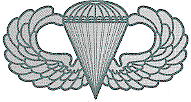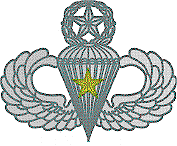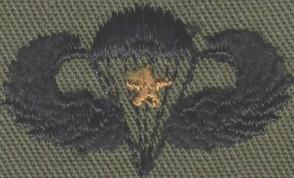
The first Parachute badge was designed during World War II by Captain (later Lieutenant General) William P. Yarborough of the 501st Parachute Battalion. A memorandum of record written by Captain Yarborough on April 22, 1941, tells the story of the birth of the parachute badge.
“On March 3, 1941, I was ordered to Washington to report to the Adjutant General for temporary duty in the Office of the Chief of Infantry. My mission was the procurement of a suitable parachutist badge with would meet with the approval both of the War Department and the Commanding Officer of the 501st Parachute Battalion. Major Miley (commander of the 501st), before my departure, gave me full authority to approve any design that I considered acceptable, and to do so in his name. The same authority was delegated to me in the name of the Chief of Infantry.

“I drew the original sketch in the office of Lieutenant Colonel Beuchner, G-3; a finished copy of my original sketch was prepared in the office of the Quartermaster General. Through the help of Mr. A.E. Dubois, in the Quartermaster General’s office, 350 of the badges were procured from the Bailey, Banks & Biddle Company in Philadelphia and were in the hands of the Commanding Officer of the 501st Parachute Battalion by March 14, 1941. This is believed to have been an all time speed record for War Department Procurement.”
“I personally took the correspondence relative to the badge’s approval from one office to another until the transaction was complete. This operation took me one entire week, eight hours a day.”
Captain Yarborough even applied for a patent to protect the design from unauthorized reproduction. On February 2, 1943, Patent #134963 was granted for “A Parachutist’s Badge” for a period of three and one-half years.
The Parachutist Badge was formally approved on 10 March 1941. The senior and master parachutist badges were authorized by Headquarters, Department of the Army in 1949 and were announced by Change 4, Army Regulation 600-70, dated 24 January 1950.
Description: An oxidized silver badge 1 13/64 inches in height and 1 1/2 inches in width, consisting of an open parachute on and over a pair of stylized wings displayed and curving inward. A star and wreath are added above the parachute canopy to indicate the degree of qualification. A star above the canopy indicates a Senior Parachutist; the star surrounded by a laurel wreath indicates a Master Parachutist.
Symbolism: The wings suggest flight and, together with the open parachute, symbolize individual proficiency and parachute qualifications.

Basic Parachutist: Awarded to any individual who has satisfactorily completed the prescribed proficiency tests while assigned or attached to an airborne unit or the Airborne Department of the Infantry School; or participated in at least one combat parachute jump.

Senior Parachutist: Participated in a minimum of 30 jumps to include 15 jumps with combat equipment; two night jumps, one of which is as jumpmaster of a stick; two mass tactical jumps which culminate in an airborne assault problem; graduated from the Jumpmaster Course; and served on jump status with an airborne unit or other organization authorized parachutists for a total of at least 24 months.

Master Parachutist: Participated in 65 jumps to include 25 jumps with combat equipment; four night jumps, one of which is as a jumpmaster of a stick; five mass tactical jumps which culminate in an airborne assault problem with a unit equivalent to a battalion or larger; separate company/battery or organic staff of a regiment size or larger; graduated from the Jumpmaster Course; and served in jump status with an airborne unit or other organization authorized parachutists for a total of at least 36 months.
COMBAT PARACHUTIST BADGES
Stars representing participation in combat jumps had been worn unofficially on parachute wings during and after World War II. This practice did not gain official sanction until after the 1983 invasion of Grenada, Operation Urgent Fury. On October 25, 1983 over 500 Army Rangers from the 1st and 2nd Ranger Battalions made a combat jump into Point Salines Airport, Grenada. The addition of stars to the basic, senior and master parachute wings for each combat jump were approved by Headquarters, Department of the Army on December 14, 1983.
Small stars are superimposed on the appropriate badge to indicate combat jumps as follows:





One combat jump: A bronze star centered on the shroud lines 3/16 inch below the canopy.
Two combat jumps: A bronze star on the base of each wing.
Three combat jumps: A bronze star on the base of each wing and one star centered on the shroud lines 3/16 inch below the canopy.
Four combat jumps: Two bronze stars on the base of each wing.

Five combat jumps: A gold star centered on the shroud lines 5/16 inch below the canopy.
SUBDUED BADGES: Subdued badges are authorized in metal and cloth. The metal badge is black. The cloth badge is of olive green base cloth with the wings, parachute, star and wreath embroidered in black.
MINIATURE BADGES: Dress miniature badges are authorized in the following sizes: Master – 13/16 inch in height and 7/8 inch in width; Senior – 5/8 inch in height and 7/8 inch in width; Parachutist – 15/32 inch in height and 7/8 inch in width.
Illustrations & Insignia Descriptions provided by the
U.S. Army Institute of Heraldry
